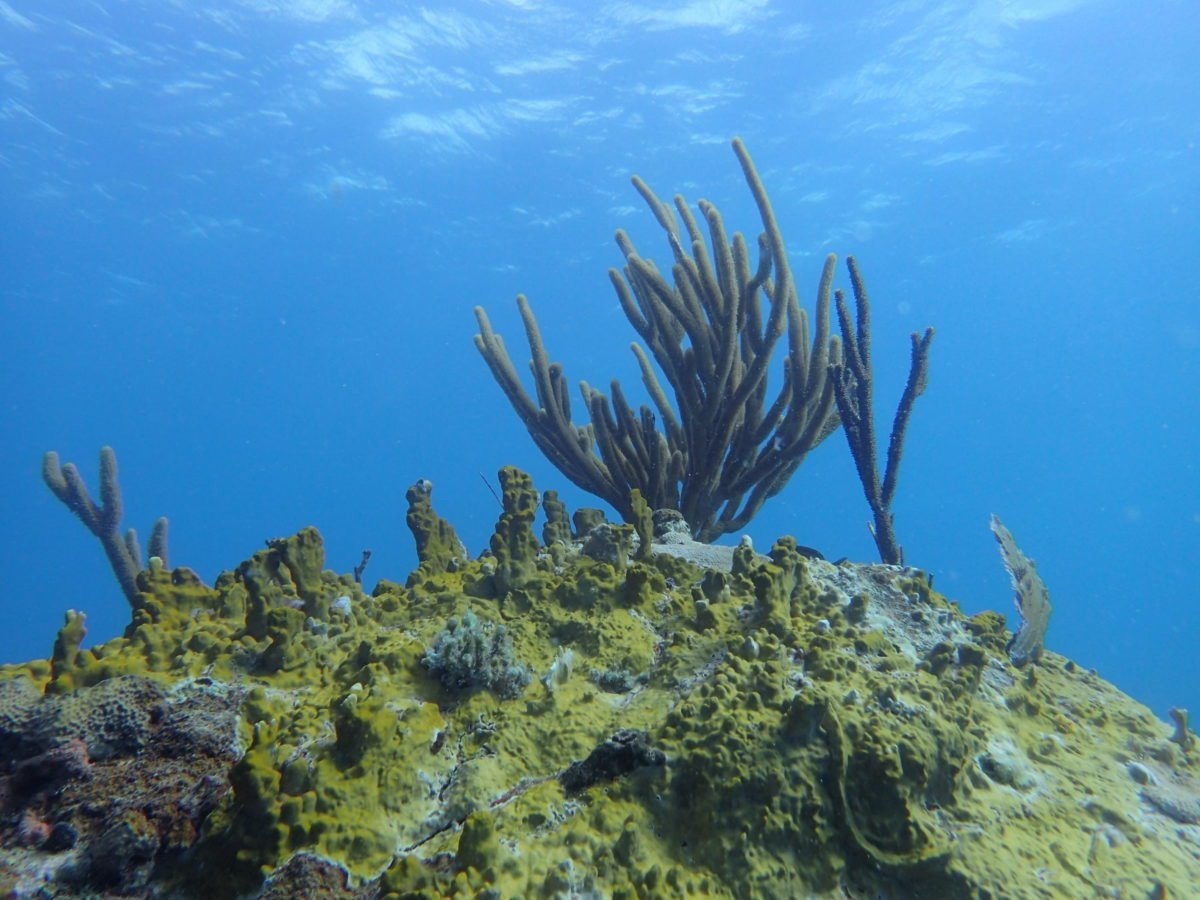The discovery of a new source of underwater caffeine is the result of new research looking into the influence of chemical compounds released into seawater by corals.

Invasive crustose coralline algae (yellow/brown color) that has overgrown reef corals in the Virgin Islands National Park in St. John. A WHOI-led study found this alga released caffeine in high quantities, impacting healthy reef growth. Image Credit: Cynthia Becker © Woods Hole Oceanographic Institution.
The research revealed that the organic chemical substances produced by metabolism, called metabolites or exudates, differ greatly between coral species and have varied influences on the abundances and compositions of reef organisms.
This differential metabolite release from benthic reef organisms is especially important in the Caribbean, where coral dominance is moving from hard stony corals to soft octocorals due to human-caused stressors like overfishing, eutrophication, and global climate change.
The research “demonstrates the importance of benthic exudates for structuring microbial communities on oligotrophic reefs by focusing on the exudates released from abundant stony corals, octocorals, and an invasive alga,” according to the study headed by investigators from the Woods Hole Oceanographic Institution (WHOI). The study was published in the ISME Communications journal.
We wanted to know what are the molecules that coral organisms release into the environment, and how do those molecules impact the reef microbes in the seawater surrounding the corals.
Laura Weber, Study Lead Author and Information Systems Associate, Marine Chemistry & Geochemistry Department, Woods Hole Oceanographic Institution
Weber adds, “As the species composition of these reefs shifts, it is likely changing the chemicals that are released on the reef that then will have impacts on the microbial community. We need to pay more attention to how changes in reef structure and species composition might influence the microbes that live on the reef, leading to more feedbacks in terms of reef health.”
Weber explained that knowledge about the microorganisms on reefs, how they function, and how they would probably contribute to the health of corals and reefs themselves is “pretty much an untapped area to explore.”
Details about the caffeine connection are given below.
Researchers used organisms obtained from the Virgin Islands National Park, including stony corals, octocorals, and an invasive encrusting alga named Ramicrusta textilis, to gather exudates from six species of Caribbean benthic organisms in a laboratory setting. Amazingly, the scientists found caffeine was abundantly released by R. textilis.
The observations further “demonstrate that exudates from benthic organisms contribute to the complex pool of extracellular metabolites in reef seawater and that exudate composition varies significantly by species,” according to the research.
As to why R. textilis produces caffeine, the research underlines that caffeine production has not been investigated widely for marine organisms, but that it is a frequent metabolite generated by land plants to prevent herbivores and dangerous microorganisms.
According to the study, these characteristics “could contribute to the ability of R. textilis to invade and flourish on Caribbean reefs.”
“Given the growing prevalence of Ramicrusta on diverse Caribbean reefs, follow-up research examining the ecological significance of its metabolites on microbes and other reef organisms is needed.”
The current research “is an important step forward in identifying chemical signals that can help scientists assess reef health. Similar to human health diagnostics, the chemical signals within a reef ecosystem are intimately linked to the functions of the symbiotic relationships within reefs,” according to Elizabeth Kujawinski, Co-Author of the paper.
Kujawinski is a Senior Scientist in WHOI’s Marine Chemistry & Geochemistry Department and director of the Center for Chemical Currencies of a Microbial Planet (C-CoMP), a National Science Foundation Science and Technology Center that is based at WHOI.
A key implication of the research, according to Co-Author Amy Apprill, Associate Scientist at WHOI’s Marine Chemistry & Geochemistry Department, is that a diversified benthic community contributes to a more diverse metabolite pool and presumably promotes a more diverse microbial community.
We are trying to build kind of a library of what microbes and metabolites are present on reefs. My dream is to be able to go out to a reef, take a bucket of reef water, screen it for microbes and metabolites, and be able to tell something about the health of that ecosystem.
Amy Apprill, Study Co-Author and Associate Scientist, Marine Chemistry & Geochemistry Department, Woods Hole Oceanographic Institution
Amy Apprill adds, “This is so important to do because the current methods to monitor reefs are highly visual-based, and it can take months or years to determine if coral is sick or growing. Metabolites and microbes have the potential to be really sensitive sensors for reef health.”
The study was supported by the National Oceanic and Atmospheric Administration and the National Science Foundation.
Journal Reference:
Weber, L., et al. (2022) Benthic exometabolites and their ecological significance on threatened Caribbean coral reefs. ISME Communications. doi.org/10.1038/s43705-022-00184-7.